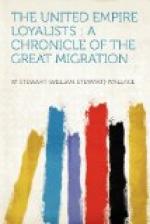Sir Frederick Haldimand Offered the Loyalists a wide choice of places in which to settle. He was willing to make land grants on Chaleur Bay, at Gaspe, on the north shore of the St Lawrence above Montreal, on the Bay of Quinte, at Niagara, or along the Detroit river; and if none of these places was suitable, he offered to transport to Nova Scotia or Cape Breton those who wished to go thither. At all these places settlements of Loyalists sprang up. That at Niagara grew to considerable importance, and became after the division of the province in 1791 the capital of Upper Canada. But by far the largest settlement was that which Haldimand planned along the north shore of the St Lawrence and Lake Ontario between the western boundary of the government of Quebec and Cataraqui (now Kingston), east of the Bay of Quinte. Here the great majority of the Loyalists in Canada were concentrated.
As soon as Haldimand received instructions from England with regard to the granting of the lands he gave orders to Major Samuel Holland, surveyor-general of the king’s territories in North America, to proceed with the work of making the necessary surveys. Major Holland, taking with him as assistants Lieutenants Kotte and Sutherland and deputy-surveyors John Collins and Patrick McNish, set out in the early autumn of 1783, and before the winter closed in he had completed the survey of five townships bordering on the Bay of Quinte. The next spring his men returned, and surveyed eight townships along the north bank of the St Lawrence, between the Bay of Quinte and the provincial boundary. These townships are now distinguished by names, but in 1783-84 they were designated merely by numbers; thus for many years the old inhabitants referred to the townships of Osnaburg, Williamsburg, and Matilda, for instance, as the ‘third town,’ the ’fourth town,’ and the ‘fifth town.’ The surveys were made in great haste, and, it is to be feared, not with great care; for some tedious lawsuits arose out of the discrepancies contained in them, and a generation later Robert Gourlay wrote that ’one of the present surveyors informed me that in running new lines over a great extent of the province, he found spare room for a whole township in the midst of those laid out at an early period.’ Each township was subdivided into lots of two hundred acres each, and a town-site was selected in each case which was subdivided into town lots.
The task of transporting the settlers from their camping-places at Sorel, Machiche, and St Johns to their new homes up the St Lawrence was one of some magnitude. General Haldimand was not able himself to oversee the work; but he appointed Sir John Johnson as superintendent, and the work of settlement went on under Johnson’s care. On a given day the Loyalists were ordered to strike camp, and proceed in a body to the new settlements. Any who remained behind without sufficient excuse had their rations stopped. Bateaux took the settlers up the St




